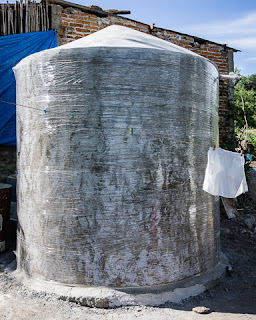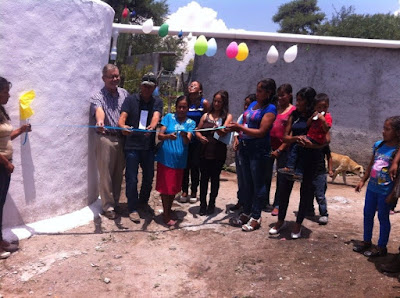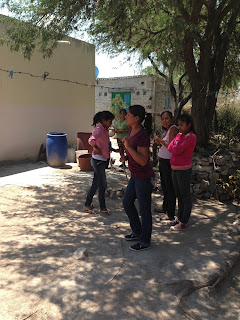May 19, 2016
Yesterday, after going to Nombre de Dios with Chela and Abel, we returned to CEDESA for additional planning of our new global grant (GG1524911) for 319 more water harvesting cisterns in San Miguel, Dolores Hidalgo, San Diego de la Union & San Luis de la Paz.
Present were Chela, Abel, Meche, Benigno, and Ceci.
We reviewed first the progress on the new education program & the principal objectives of that program. Meche has been working hard with Wendy Coulson to develop the program & didactic materials to go with that. We all agreed that in a nutshell our goals are to have people fully understand
1. the reason for cisterns is lack of an improved water source or having water that is terribly contaminated with fluoride and arsenic.
2. the cistern water is free from those poisons & they should never drink water from wells.
3. they can improve their water & health even more by integrating disinfection steps to improve the cistern water & avoid any potential biological contamination &
4. have people learn how to self-construct their water harvesting system & maintain it to get maximum benefit from it.
Those are our primary objectives for this project &grant. However we also will be using this opportunity to continue to develop the communities' capacity to work together to analyze their problems & seek solutions (resources).
We'd like to build on this opportunity so that they can take advantage of other opportunities such as backyard gardens, natural medicine, beekeeping, & other eco-technologies such as gray water filtering & the eco-cina stoves. We'd like the cistern projects to continue to be the first step in the long process of community empowerment.
The education program is ready now to “beta test” in the first communities. We are going to start in Boca de la Cañada (San Miguel) in two weeks & then in Las Claveles (Dolores) after that.
We will present the didactic materials in the “final draft” format & then make adjustments before going to press & printing enough materials to carry us through the project.
Everyone in the communities are enthusiastic & champing at the bit to get started. They all want to work through the summer rainy season in order to be able to harvest at least a little rain before the dry weather returns in the fall.
CEDESA is going to work up a draft schedule next week so we can plan out each mini-project. They are talking about doing as many as four different communities per month. Yikes, that is going to be a lot of work for all of us!
As we worked through potential pitfalls & bottlenecks in this ambitious program, we realized that we would need another technician in addition to Benigno & Abel to be able to do the site visits in each community during the construction process.
A great solution was devised that will also allow us to continue to develop our youth program in the process. We will select a young person in each community where we are working to become an expert in construction & maintenance of the systems. This person will do the project monitoring throughout the construction process & will be report & consult with Abel &/or Benigno as the mini-project proceeds. Instead of having a once a week visit from the technician, we will have someone there overseeing the construction on a daily basis as each group builds cisterns at each home.
Once the project is complete we will be leaving behind “a community expert” who can continue to monitor cisterns & even assist in repairs as needed. We already have a budget for an albanil for the pilot week. Since each group is now obligated to provide an albanil throughout the mini-project including the pilot cistern week, those funds can be used as a stipend for developing our new community expert. CEDESA will be responsible for handling the payment process.
We also reviewed the financial resources available in the grant so that we could come up with a simplified billing plan. When we combine our organization budget with our education teaching budget, we have 2,400 pesos for Pre-Pilot expenses. For the Pilot stage of the project we have $4,750 in funds available. And for post-project monitoring & evaluation we have 900 pesos available.
We budgeted for 11 mini-projects as we were developing the project but as the number of cisterns grew the number of mini-projects is likely to be 15 to 18 … thank heavens for our contingency budget!
CEDESA is to be responsible for tracking certain costs/expenses each month & reporting them to Rotary for reimbursement. They need to record all KM driven in CEDESA vehicles in executing the projects to be reimbursed @ 3.5 pesos / KM. They also need to keep all tickets from using public transportation so that can be reimbursed as well up to a total of $9000 for the project. We will also be providing an $800 peso phone allowance per month to be split up between the various promotors & technicians.
Equipment: We need to get the new vehicle as soon as possible. Rotary has $5,000 dollars to contribute to that. CEDESA has 30,000 pesos set aside as well. We are going to purchase one “very good” vehicle that will last many years into the future for project monitoring. We are going to invest about 10,000 pesos of that money in upgrading an existing vehicle. Even with two new vehicles in play, transportation will still be a headache for CEDESA.
The electrode in the fluoride testing laboratory has failed & we are looking into replacing that. Initial quotations that Meche got are expensive … about US$1,500. We had not counted on needing this within the time frame of this grant. We will probably reduce our “tools” budget to get this back on-line &I will try to see if we can find outside resources to help cover this unexpected expense.
We are working to be able to get the communities on the edges of San Diego de la Union & San Luis de la Paz involved in this grant. To do so, the two “subgroups” will have to work under UCCANG.
UCCANG is responsible for carrying out several functions … community selection, receiving solicitudes & for providing monitoring and evaluation for six months after the construction phase. Integrating them into UCCANG does not seem to be a problem. The two subgroups are SECOPA (Servicios Comunitarios de Pozos Ademada – San Diego Union) and CUVA (Comunidades Unidas Para La Vida y Agua – San Jose Iturbide).
Recently a well in the San Jose Iturbide area, in the community of La Cantera, was discovered to have radioactivity in the water. There has been a high rate of documented child leukemia in that town as well. Dr. Ortega of UNAM is studying the problem to determine if this is an isolated instance of industrial contamination or if it is going to be as a result of the ever-challenging problems we are facing in the aquifer. There are 120 affected families & the government is, of course, denying that there is a problem.
Submitted by: Lee Carter




































